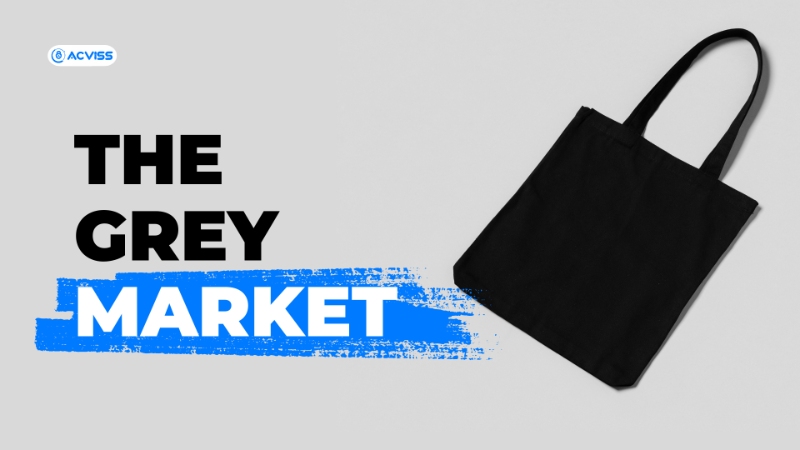
The global market has been under the chokehold of the counterfeit threat. But an even grave problem has been lingering on top of businesses for decades. The Grey Market. The grey market is a term used to describe the sale of goods through unauthorized channels. These channels may include individuals or organizations that are not authorized by the manufacturer or distributor to sell the product. This can include retailers, distributors or even individuals who purchase the product from an authorized source and then resell it without permission. While grey market goods may appear to be a good deal at first glance, they can be a hidden trap for consumers.
It's estimated that the grey market for mobile products alone costs around $600 million for the economy, with Apple and Samsung products leading the market with 80 to 90% of it.
Grey market vs Counterfeit Market?
Counterfeit is illegally manufactured goods that use the brand’s name, logo or design to lure in innocent customers to scam them. These products are dangerous to the brand and the customers because they take away the original business's profits and can be a threat to the customer's safety.
But grey market on the other hand is products that are actually manufactured by a real brand but are sold through unauthorized distribution channels. The common instances of the grey market are when products sold specifically for a region or a country are sold by someone else in another region without authorization. The major problem with grey market products is that they won’t hold the manufacturer’s warranty or technical support the original products will have. This can become a significant setback for people who aren’t aware of the product.
FMCG industry faces the worst counterfeit threats. Click here to learn more.
Why are Grey Market Goods a Hidden Trap?
It was found that over 60% of the products sold on online marketplaces like Amazon and eBay were counterfeit or grey market goods. While the lower prices of grey market goods may be appealing to consumers, there are several reasons why they can be a hidden trap.
No Manufacturer Warranty
One of the biggest risks of buying grey market goods is that they may not come with a manufacturer's warranty. This means that if the product fails or is defective, the consumer may be left with no recourse for repair or replacement. Without a warranty, the consumer will be responsible for any repairs or replacements, which can be costly and time-consuming.
Counterfeit Products
There's always a risk of getting fake goods while purchasing from the grey market. Counterfeit products are one that are designed to look like the original but may not function properly or may even be dangerous to use. While counterfeit products are illegal, they can be difficult to spot and grey market goods are often a prime target for counterfeiters.
No Technical Support
Grey market goods may lack technical support from the manufacturer. This means that if the consumer has a question or problem with the product, they may not be able to get the help they need. This can be especially frustrating for complex products like electronics or appliances.
Limited Availability of Replacement Parts
These products may be difficult to repair or maintain due to the unavailability of replacement parts. Authorized dealers and distributors have access to a network of replacement parts, but grey market sellers may not. This can make it difficult or impossible to repair the product if it breaks down.
Are the grey Market the same as Black Market?
No, the grey market and the black market are not the same.
The black market deals in the illegal trade of goods and services that are not permitted by law. This can include lethal and illegal drugs, weapons or counterfeit goods, among other things. Transactions that take place in the black market are typically done in secret and without government oversight, making them dangerous and often harmful to society. On the other hand, the grey market refers to goods that are genuine and legitimate products being sold outside of the manufacturer's authorized distribution channels.

How can you avoid Grey Market Goods?
Grey market goods can do a lot of harm if not handled carefully. That’s why consumers need to be aware of the whereabouts of the products they want to purchase. So let's take a look at some steps consumers can take to protect themselves:
1. Buy from authorized dealers: To ensure that you're getting a genuine product with a manufacturer's warranty, it's best to buy from authorized dealers and distributors. They will walk you through the entire process and will offer the best after-sales services. So it is better to choose an authorized dealer than a cheap discount at a grey market.
2. Check the product serial number: If you're buying a product second-hand or from a source you're not sure about, check the product serial number with the manufacturer. The real products will have a serial number that the customer can verify by themselves through their website or mobile app. If it's not working then you may need to ditch them.
3. Research the seller: Before making a purchase, do your research on the seller. Check their ratings and reviews on the platform where you're making the purchase. Look for any red flags, such as low ratings or negative reviews. Especially look for what other products they are selling, if the products don’t match it is better to leave.
4. Beware of deals that are too good to be true: If the price of a product seems too good to be true, it probably is. Be wary of deals that are significantly lower than the market price.
5. Be cautious while online shopping: Online marketplaces like Amazon, Alibaba and eBay can be great places to find deals, but they can also be prime targets for grey markets and counterfeit products. Be cautious when buying from these platforms and do your research on the seller before making a purchase.
6. Read the fine print: Before making a purchase, read the fine print. These are small texts written on the packaging at the bottom. Always make sure you understand the warranty and return policies for the product. Most customers fall into the trap because they don’t try to read the conditions and terms of the product before buying it.
Don't know what to do after spotting a fake product: Click to learn
Can Brands Avoid the Grey Market
Yes, they can. But unlike counterfeits, brands can face a hard time identifying grey market products. Because these products are produced by the brands themselves and will have every feature the original products do. So the end user will not be able to if it came from a grey market.
The grey market has been thriving since the wide spread popularity of the e-commerce platforms. This has caused an even greater panic for the brands and the customers. And the only solution available is for the brands to employ an AI-based anti-counterfeit solution to monitor the internet for unauthorized use of their trademarks.
Truviss by Acviss can scan the domain, social media, apps and products to find fake listings of your products. By employing AI and ML algorithms, they can easily identify and eliminate fake offers, ads, posts and content that infringes your Intellectual property rights. This ensures that your products will be sold only through authorised channels and dealers.
In short!
While grey market goods may seem like a good deal at first glance, they can be a hidden trap for consumers. The risks associated with these products, including the lack of warranty, counterfeit products and limited technical support, can end up costing consumers more in the long run. To protect yourself from the risks associated with grey market goods, it's important to do your research and be cautious when making purchases from online marketplaces. By taking these steps, you can ensure that you're getting a genuine product with the support and protection you need.



